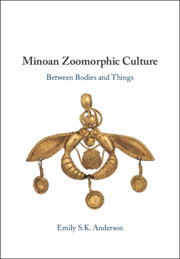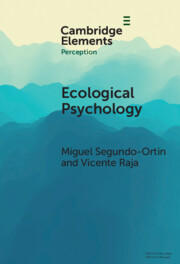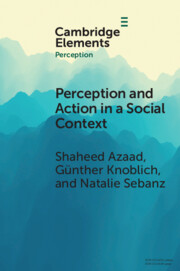42 results
Concluding Thoughts
-
- Book:
- Minoan Zoomorphic Culture
- Published online:
- 17 May 2024
- Print publication:
- 06 June 2024, pp 372-379
-
- Chapter
- Export citation
One - Life among the Animalian in Bronze Age Crete and the Southern Aegean
-
- Book:
- Minoan Zoomorphic Culture
- Published online:
- 17 May 2024
- Print publication:
- 06 June 2024, pp 1-37
-
- Chapter
- Export citation

Minoan Zoomorphic Culture
- Between Bodies and Things
-
- Published online:
- 17 May 2024
- Print publication:
- 06 June 2024

Ecological Psychology
-
- Published online:
- 27 March 2024
- Print publication:
- 18 April 2024
-
- Element
- Export citation
Chapter 1 - Language as a Physical Tool
- from Part I - Language and Its Power
-
- Book:
- The Freedom of Words
- Published online:
- 20 July 2023
- Print publication:
- 10 August 2023, pp 15-51
-
- Chapter
- Export citation
5 - People
-
- Book:
- Linguistic Landscapes
- Published online:
- 08 June 2023
- Print publication:
- 22 June 2023, pp 125-160
-
- Chapter
- Export citation
9 - Making the Ethical in Social Interaction
- from Part II - Aspects of Ethical Agency
-
-
- Book:
- The Cambridge Handbook for the Anthropology of Ethics
- Published online:
- 11 May 2023
- Print publication:
- 25 May 2023, pp 231-250
-
- Chapter
- Export citation
13 - An Aptitude Model for Translating and Interpreting
- from Part III - Innovative Perspectives and Paradigms
-
-
- Book:
- Language Aptitude Theory and Practice
- Published online:
- 27 May 2023
- Print publication:
- 27 April 2023, pp 326-354
-
- Chapter
- Export citation
PINS, PESTLES, AND WOMEN: A MATERIAL APPROACH TO FEMALE VIOLENCE IN ANCIENT GREECE
-
- Journal:
- Greece & Rome / Volume 70 / Issue 1 / April 2023
- Published online by Cambridge University Press:
- 07 March 2023, pp. 71-99
- Print publication:
- April 2023
-
- Article
-
- You have access
- Open access
- HTML
- Export citation
Three - Grounding Experience
- from Part I - Grounds
-
- Book:
- The Anthropology of Intensity
- Published online:
- 05 May 2022
- Print publication:
- 19 May 2022, pp 76-102
-
- Chapter
- Export citation
CURSE TABLETS: THE HISTORY OF A TECHNOLOGY
-
- Journal:
- Greece & Rome / Volume 69 / Issue 1 / April 2022
- Published online by Cambridge University Press:
- 07 March 2022, pp. 120-134
- Print publication:
- April 2022
-
- Article
-
- You have access
- Open access
- HTML
- Export citation
2 - Fundamental Considerations of Teaching with Mobile Technologies
-
- Book:
- Mobile Assisted Language Learning
- Published online:
- 23 December 2021
- Print publication:
- 06 January 2022, pp 21-44
-
- Chapter
- Export citation

Perception and Action in a Social Context
-
- Published online:
- 26 November 2021
- Print publication:
- 23 December 2021
-
- Element
- Export citation
A USER-CENTRED DESIGN FRAMEWORK FOR THE DEVELOPMENT OF SPEECH AND LANGUAGE THERAPEUTIC TOYS
-
- Journal:
- Proceedings of the Design Society / Volume 1 / August 2021
- Published online by Cambridge University Press:
- 27 July 2021, pp. 303-312
-
- Article
-
- You have access
- Open access
- Export citation
8 - Violations and Medication Safety
-
- Book:
- Medication Safety during Anesthesia and the Perioperative Period
- Published online:
- 09 April 2021
- Print publication:
- 04 March 2021, pp 130-155
-
- Chapter
- Export citation
6 - Why Failures Occur in the Safe Management of Medications
-
- Book:
- Medication Safety during Anesthesia and the Perioperative Period
- Published online:
- 09 April 2021
- Print publication:
- 04 March 2021, pp 87-105
-
- Chapter
- Export citation
Chapter 9 - Designing and Resisting Artefacts
- from Part III - Necessary Extensions
-
- Book:
- The Psychology of Social Influence
- Published online:
- 19 December 2020
- Print publication:
- 07 January 2021, pp 188-214
-
- Chapter
- Export citation
12 - Phenomenology of Corporeality (and Spatiality) in Anorexia Nervosa with a Reference to the Problem of Its Temporality
- from Part III - Borderline Personality and Eating Disorders
-
-
- Book:
- Time and Body
- Published online:
- 30 October 2020
- Print publication:
- 12 November 2020, pp 263-281
-
- Chapter
- Export citation
Paper and Culture in Medieval England
-
- Book:
- Paper in Medieval England
- Published online:
- 17 September 2020
- Print publication:
- 01 October 2020, pp 1-21
-
- Chapter
- Export citation



